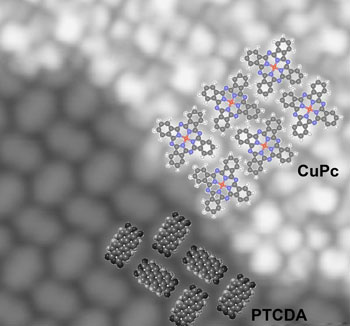| Mar 09, 2012 |
Strong Grip - Unexpected interaction between organic semiconductors
|
|
(Nanowerk News) Jülich physicists have discovered an unexpectedly strong bond between organic layers. Such structures are still puzzling scientists throughout the world. These structures form the basis for novel electronic components made from organic semiconductors that are now increasingly used in smart phones and television sets. The results have been published in the highly respected journal Physical Review Letters ("Commensurate Registry and Chemisorption at a Hetero-organic Interface").
|
 |
| Image taken with a scanning tunnelling microscope at -260 °C: in the top right-hand part of the picture, a thin layer of copper phthalocyanine has become attached to a lattice made of PTCDA. The agreement in the arrangement of the different molecules indicates the strong bonding between the two layers.
|
|
Organic semiconductors are cheap to produce, can be flexibly shaped and are relatively insensitive to external influences. In principle, they could in future even be simply printed on plastic foils. They are already widely used as organic light-emitting diodes (OLEDs), particularly in smart phones, because they consume so little power. Nevertheless, the electronic properties of these complex materials still remain largely unknown. Researchers are particularly interested in the interfaces because component performance decisively depends on how well contacts can be created with other organic and metallic conductors. The stronger the bond, the better electrons can pass from one material to the other – and the more power or light can be produced by solar cells or light-emitting diodes.
|
|
However, organic molecules do not usually form such strong bonds. "Scientists have assumed that organic materials only interact among themselves via weak van der Waals forces. Only in contact with certain metals do they display stronger bonding known as chemisorption," says Dr. Christian Kumpf from Forschungszentrum Jülich. "For the first time, we have been able to demonstrate such chemisorption between two organic layers, which we applied to a silver crystal by chemical vapour deposition." Such sandwich-like structures are also found in OLEDs and usually consist of several organic layers between two metallic conductors.
|
|
For the analysis, Kumpf and his colleagues made use of PTCDA, an organic semiconductor material, and copper phthalocyanine, which is frequently used as a dye. They then investigated the layers, which are only one molecule thick, using various highly specialized measuring techniques. By means of ultraviolet photoelectron spectroscopy (UPS), the researchers were able to show that a change is transferred between the organic semiconductors. They also used scanning tunnelling microscopy (STM) and low-energy electron diffraction (LEED) to demonstrate that the arrangement of the molecules is transferred to the next layer in the order of the strong bonding, almost like a photocopy.
|
|
It has been known for some time that certain metals can establish such strong interactions with an organic semiconductor. In his earlier work, Kumpf himself contributed to research in this field, even before moving to Prof. Stefan Tautz's group in Jülich in 2008. "What is new is that the charge transfer takes place between these organic materials, that was rather unexpected. These findings will undoubtedly be exploited in the development of new organic semiconductors," says Tautz, director at the Jülich Peter Grünberg Institute (PGI-3: Functional Nanostructures at Surfaces). There is, however, still a long way to go since industrial manufacturing processes and laboratory requirements are quite different; the latter being more concerned with reproducibility and precision.
|

